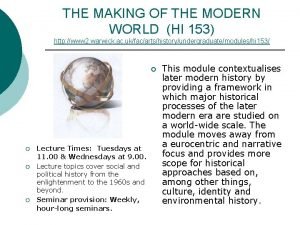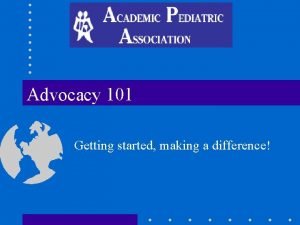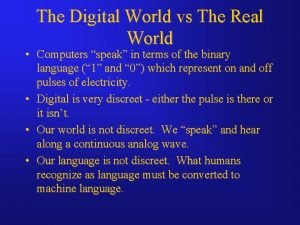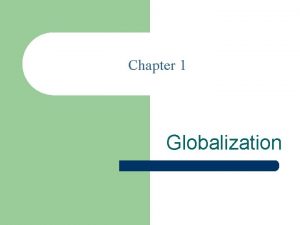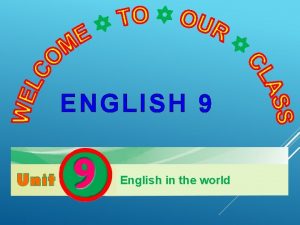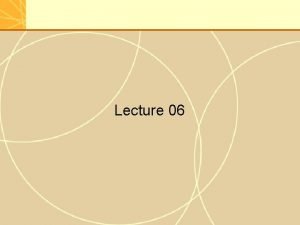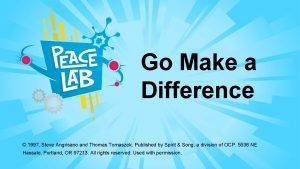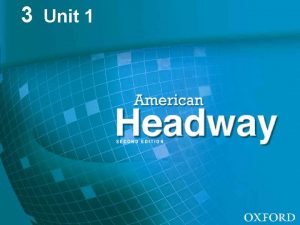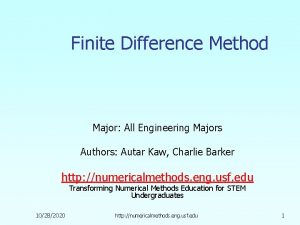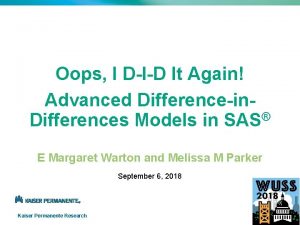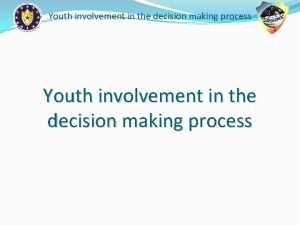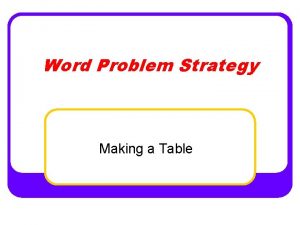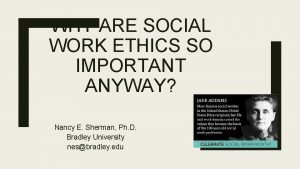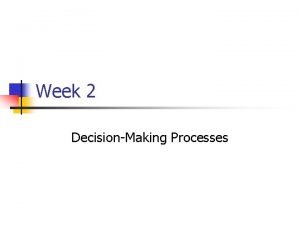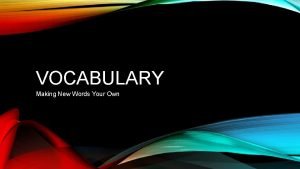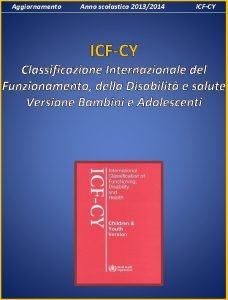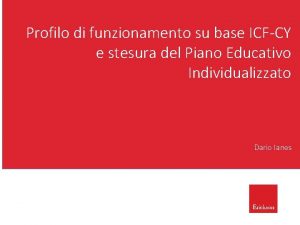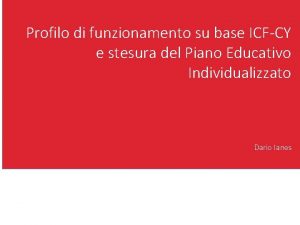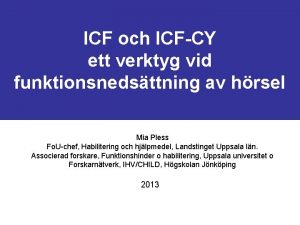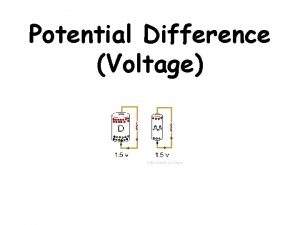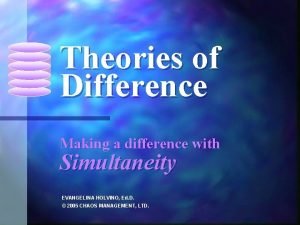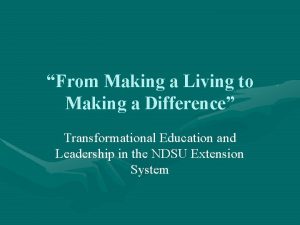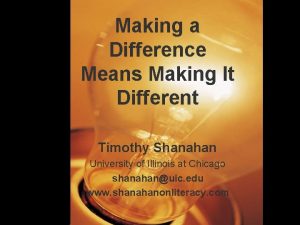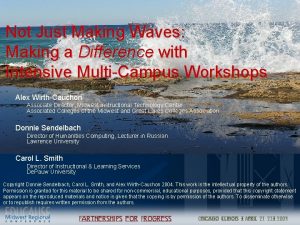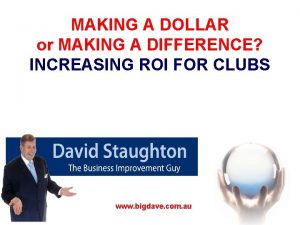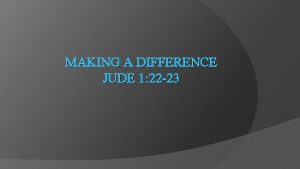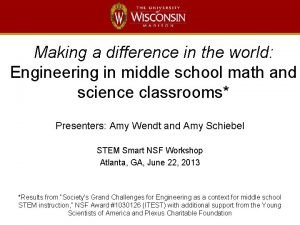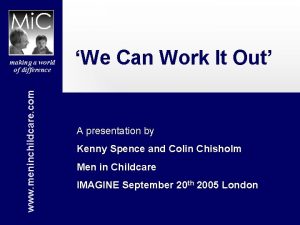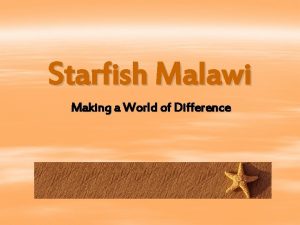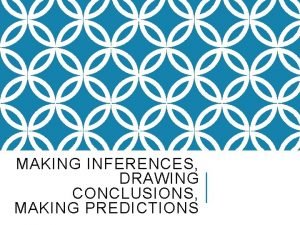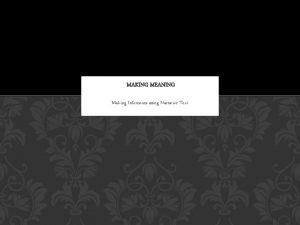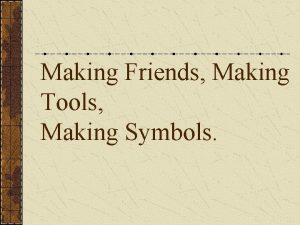Making a World of Difference The ICFCY as









































































- Slides: 73

Making a World of Difference: The ICF-CY as a Tool for Building Global Communities of AAC Providers ISAAC, Barcelona, Spain July 27, 2010

Sharon M. Rogers, Ph. D. , CCC-SLP Adjunct Faculty in AAC California State University Fullerton SMRsp@aol. com www. drsharonrogers. com

International Classification of Functioning, Disability, Health

ICF Classifications and Codes Functioning and Disability Body Functions (b 110 -b 899) Body Structures (s 110 -s 899) Activities and Participation (d 110 -d 999) Contextual and Personal Factors Environmental products/Technology, support, services, attitudes (e 110 to e 599) Personal (not yet coded)

ICF Focus on Health is Physical Mental Social well being Overall quality of life Health increases capacity to live a full life and develops individuals economically and socially.

WHO -- Need for ICF-CY Consequences of diseases/diagnosis were not predictable in functioning and unidirectional. Different diagnosis but common communication needs. Quality of life more dependent on multiple factors, including social interaction, than on body function and body structures only. Children and youth are developing i. e. language acquisition.

C (Children) and Y (Youth) Bates in 1976 (Hyter, 2007) wrote, Surely it has been true all along that the only real “language acquisition device” is the whole child growing up in a social world. (p. 128)

ICF-CY Team Member Mats Granlund Professor in Psychology at Jönköping University, School of Health Science, Swedish Institute for Disability Researcher

ICF-CY Team Member Included ASHA representative Travis Threats, Saint Louis University International=World Health Organization (2006) Classifications adopted by ASHA, physical and occupational therapists

ICF-CY Classifications and AAC Who? Individual Body Functions, Body Structures, Personal Factors -- AAC topics What? Activity/Participation with augmenting and having alternative communication How? Environment includes technology, support, services, systems, attitudes thus AAC When? Today and tomorrow Where? Across environments -- AAC opportunities and barriers home, school, community Why? Quality of life improves with Participation

Combines Bio-Psycho-Social Models Biology represented in Body Structures Psychological described in Body Functions Social Activities and Participation Social Context/Environmental Technology for AAC Social Context identify Personal Factors

Participation Matters Limited participation often is due to cultural myths and negative attitudes about competence. Society’s accumulated myths and fears about disability are as handicapping as are the physical limitation from actual impairment. (Brennan, 2007)

Environmental Factors Matter Products and technology (for communication)--availability of AAC Natural environment and human made changes Personal support and relationships Attitudes toward AAC Services, systems and policies in physical environment

Social Model Matters Each function in the child’s cultural development appears twice 1 st on the social level and later on the individual level 1 st between people and then inside the child. (Vygotsky)

Personal Factors Matter Age Gender Interests/Motivation/ preferences Family-beliefs Culture -- including unique stories, selfconfidence, and experience with communication failure

ICF-CY Case Study Body Structure Body Function Activity. Participation Environment Tools Support Personal Factors

Previous Focus on Body Functions and Structures Educator Medical--school nurse Physical therapist Occupational therapist Speech language pathologist

Educational Report--Part 1 Joelle is a 12 year old female who qualifies for special education services due to a neuromuscular impairment and severe orthopedic disability. She continues to qualify for low incidence funding. Physical support is required for Joelle to succeed in the general education class setting.

Educational Report--Part 2 Health: Good health overall, diagnosis Werdnig-Hoffman syndrome. Uses motorized wheelchair for mobility. Snellen Distance Activity 20/40 with glasses, normal bilateral hearing Academics: Reading, writing above grade level, math at grade level. Expressive communication: uses eye gaze, eyebrows, and hands to write.

Nurse’s Report Joelle is 12 year old female. Height and weight within normal limits. Blood pressure good. Tracheostomy requires frequent suctioning. Ventilator and oxygen every 4 hrs. respiratory care. Gastrotomy tube for feeding at noon. Medications at school Tylenol and Albuterol as needed.

Physical Therapy Report Joelle operates motorized wheelchair with joystick. Movement of legs and arms approximately 2 inches. Support while sitting with bands at head, chest, and hips. Spinal rod in place.

Occupational Therapy Report Hand use: Right hand. Range of motion limited to 6 inches. She holds pencil or roller pen with index and third fingers on right hand to write. These fingers access 2 light touch switches on computer for typing with Morse code. Left hand: Palm rotates track ball to control computer mouse. Left hand grasps styrofoam meat tray as writing surface.

Speech Language Pathology Report Joelle is learning to use speech generating device. She is able to access programmed files but often does not use speech generating device for daily communication. Goal: Joelle will use speech generating device to greet peers and teachers 5 x daily, ask questions 3 x daily, make comments 3 x daily, request nurse assistance as needed.

What Difference Would ICF-CY make?

ICF-CY Body Structures Eyes, ears within normal limits Voice and Speech mechanism trachestomy Nervous system-progressive motor neuron degeneration

ICF-CY Body Functions Learning and applying knowledge: Reads and writes Sensory: Wears glasses, hearing good Movement: Right hand dominant Limited use of limbs Joystick used to direct wheelchair Voice and Speech: Vocalizations limited due to weak breath support Receiving communication, excellent Producing communication --50% intelligibility with familiar partners --nonverbal communication with eyes and eyebrows

ICF-CY Body Functions Cardiovascular/ digestive/ neuromuscular/ skeletal Spinal muscular atrophy Feeding tube, Spinal rod, Head support Oxygen with ventilator every 4 hours

What Does ICF-CY Add? Activities and Participation -- social Environment -- technology, support, services Personal factors -- motivation, cultural influences

ICF-CY Provides: Common language for AAC providers For improved collaboration among team members including parents and caregivers Integrated instruction across environment

ICF-CY Factors Environment at Home What to look for in video: Body Structures Body Functions How does Joelle produce communication? % intelligible Activities and Participation Environment-context for AAC Tools What high and low technology does she use? Support--Who is supportive? What services provided? Nurse monitor temperature, feeding, medication Personal factor--Motivation/interests





ICF-CY Descriptions Body functions: How does Joelle produce communication? % intelligible Activities and Participation she enjoyed Environment/Social: What tools does she have to write? What accommodations? Environment/Social: Who are her supports? Environment-Personal: What motivates her? What are interests?

ICF-CY Activities/Environment at School Activities and Participation--social Environment for AAC Tools Support personnel Location of tools, position with peers Expectations



ICF-CY Activities Participation with AAC Use Acquiring concepts General education curriculum College preparation Reading/writing/calculating Reads at grade level Likes romance novels Wrote 36 page paper on American Colonies Algebra challenging

ICF-CY Personal Factors Interests Shopping Art work with pen Fashion design Lab pathologist Contribute to society write for school yearbook. Cultural considerations

ICF-CY Environmental Factors Tools: augment nonverbal Computer with switch access AAC--Speech generating device Attitudes Support across environments Services, policies: Full inclusion Assistive Technology Access to home computer

Who Makes a Difference in Her AAC Use? Family -- parents, sibling, extended family Medical staff -- nurses, doctors Friends and classmates Educators -- including paraprofessional, bus driver Speech language pathologist Occupational therapist

Environmental Support: Caregiver I could go around the world 6 times, take every course offered at a university and still not learn as much about life and about God as I have from Joelle. ~Suzanne, Nurse

Environmental Support: Educator She teaches me to ask the right questions. ~Mr. Buck, math teacher

Environmental Support: Parent I wish I were a millionaire. I never wanted money before. I need say $35, 000 a month then I could get things done for my daughter in a timely manner. ~Jane, Joelle’s Mother

Environment Support: Community Joelle is treated as a “rock. ” She is scenery to many. It breaks my heart. ~Jane, Joelle’s Mother

ICF-CY Personal Factors Influencing Her AAC use Motivation Family values including participation in religious services, family gatherings, friends invited for sleepovers Cultural considerations.

ICF-CY--Her Attitudes Influencing AAC Use I want to be on the yearbook staff (1) to have fun (2) to use my talents (3) to serve my school. ~Joelle’s written application

ICF-CY includes Activities/Participation Communication producing: At home At school Self Care Interpersonal interaction-community

ICF-CY Includes Environment/Social Tools/products/technology Low technology High technology Support and relationships

Ideas/Goals for Joelle Technology to try Goals for success with AAC -- educational standards Collaboration across environments

Educational Standard Participation with AAC Goal and Standard 8. 2. 1 Listening and Speaking Deliver narrative presentations (e. g. biographical, autobiographical) a. Relate a clear, coherent incident, event, or situation by using well-chosen details b. Reveal the significance of and the subject’s attitude about the incident, event or situation. c. Employ narrative and descriptive strategies (e. g. relevant dialogue, specific action, physical description, background description, comparison or contrast of characters. )

ICF-CY and AAC Summary Body functions --nonverbal Body structures Activities and Participation Environment -- technology tools, support, services Personal factors -- age, gender, interests, motivation, culture

ICF-CY Codes (b, s, d, e) Further Refine Categories Levels of Participation affected by Body Functions no difference, 0 -4% of time 5 -24% of time makes a difference 25 -49% of time makes a difference 50 -95%% of time makes a difference 96 -100% of time

ICF-CY Codes Further Refine Environmental/Social + (plus) facilitating opportunities - (minus) barriers to participation

ICF-CY Qualifiers Further Refine Participation Mild to profound Performance: how person does in their natural environment Capacity without assistance -- how person does in clinical setting without assistance Capacity with assistance –- how person does in clinical setting with assistance Performance without assistance -- how person performs in environment without assistance

ICF-CY Makes a Difference Assessment for AAC Collaborate to describe body functions Look for shared activities and participation Discover personal factors-motivation Try tools of AAC (low and high technology) Instruction for AAC Goal writing -- collaboration for increase participation Instruct across environments Measure by participation

International Classification of Functioning, Disability Health

ICF-CY: A Common Language for Assessment Common language across disciplines and cultures to Describe human functioning in activities Describe disability as participation in activities Focus on participation to increase quality of life across communication partners and environments

ICF-CY and AAC Assessment 1. Interview communication partners for 2. 3. 4. 5. 6. descriptions and activities Video tape across environments Generate hypotheses for assessment-activities for participation, tools, supports, interests Conduct and videotape assessment Summarize using ICF-CY classifications Collaborate on goals and instructional strategies for increased participation

ICF-CY Interviews Describe Body Functions Communication receiving--speech, line drawings Communication producing-intelligibility Interpersonal relationships Interpret nonverbal language use by parents, educators, and SLP Hearing Them Into Voice protocol, Communication Partners’ Response, Measure of Functional Communication (www. drsharonrogers. com)

ICF-CY Participation in Social Interaction Interpret nonverbal communication I show “I like you, you are my friend” Ask or “say it, ” “give a hug” I protest Say “no, ” scream I show I don’t like a person “Ignore them, ” think they’re just curious; “Want them to accept me for what I am, I accept them for who they are”

ICF-CY Participation in Sharing Information Interpret nonverbal communication I show I understand when I “raise my eyebrows” Say I don’t know when I “raise my eyebrows and hold them up. ” Show I know names of people, actions, places when “I write, talk, read about”

ICF-CY Participation in Expressing Unique Identity Interpret nonverbal communication I may want to talk about What I may choose to do in free time Bertha, my best friend Big things I contribute to others People see that kids with disabilities can do things with a little help

ICF-CY and AAC Assessment Environment/Social Try assistive technology Speech generating devices Low tech Learn about support and relationships Discover attitudes and expectations of family and community Outline services, systems, & policies (funding)

ICF-CY Making a Difference Instruction: Goals Participation is goal In Social interaction In Sharing information In Expressing unique identity

ICF-CY Making a Difference Instruction for Communication Help communication partners learn to respond Choose topics that are age and gender appropriate, i. e. peer activities and general education curriculum Build on social engagement (peer assisted learning) and personal motivation Engage in real time, place and purpose (naturalistic environments) Instruct reading and writing with AAC for creating messages.

Communication Partners Learn to Respond to Nonverbal Social interaction Response to producing hug meaning “I like you” You do like me. I like you too. Think of all the people you love Response to screaming meaning “leave me alone” You told me “no. ” So I’ll give you a little time and come back later. Response to looking away “I don’t like that person” I understand some of how you feel. Let’s figure out what you don’t like. Where shall we begin?

Communication Partners Learn to Respond to Nonverbal Sharing information Response to raising eyebrows to say I understand. You raised your eyebrows so I know you understand. Let’s move onto the next question. Response to raising eyebrows and holding them up to say “I don’t understand. ” You told me you did not understand by raising your eyebrows and holding them, shall I explain the question using other words? You just wrote about interesting people and places. I love what you wrote. Where else can we find to hear more about these?

Communication Partners Learn to Respond to Nonverbal Expressing Unique Identity You just said “b” Do you want to talk about your friend, Bertha. Was it something that happened today? What would you like to tell me about her? Your comment is so perceptive. You do make such a difference to me too. You once told me that if I was not your daughter, you would suffer. You are right.

Instruction for Communication with AAC Teach accessible low and high technology on topics of interest with different communication partners Anticipate as a team participation opportunities/reduce barriers of using AAC

ICF-CY Making a Difference: Measure Changes Of Participation with AAC in Social interaction Sharing information Expressing unique identity Measure of Functional Communication also at www. drsharonrogers. com Goal Attainment Scale from -2 to +2

It’s All Yours: Making a World of Difference
 Icfcy
Icfcy Making inferences
Making inferences War making and state making as organized crime summary
War making and state making as organized crime summary Hát kết hợp bộ gõ cơ thể
Hát kết hợp bộ gõ cơ thể Lp html
Lp html Bổ thể
Bổ thể Tỉ lệ cơ thể trẻ em
Tỉ lệ cơ thể trẻ em Gấu đi như thế nào
Gấu đi như thế nào Chụp tư thế worms-breton
Chụp tư thế worms-breton Chúa yêu trần thế
Chúa yêu trần thế Môn thể thao bắt đầu bằng chữ đua
Môn thể thao bắt đầu bằng chữ đua Thế nào là hệ số cao nhất
Thế nào là hệ số cao nhất Các châu lục và đại dương trên thế giới
Các châu lục và đại dương trên thế giới Công thức tính thế năng
Công thức tính thế năng Trời xanh đây là của chúng ta thể thơ
Trời xanh đây là của chúng ta thể thơ Mật thư tọa độ 5x5
Mật thư tọa độ 5x5 Làm thế nào để 102-1=99
Làm thế nào để 102-1=99 Phản ứng thế ankan
Phản ứng thế ankan Các châu lục và đại dương trên thế giới
Các châu lục và đại dương trên thế giới Thơ thất ngôn tứ tuyệt đường luật
Thơ thất ngôn tứ tuyệt đường luật Quá trình desamine hóa có thể tạo ra
Quá trình desamine hóa có thể tạo ra Một số thể thơ truyền thống
Một số thể thơ truyền thống Cái miệng xinh xinh thế chỉ nói điều hay thôi
Cái miệng xinh xinh thế chỉ nói điều hay thôi Vẽ hình chiếu vuông góc của vật thể sau
Vẽ hình chiếu vuông góc của vật thể sau Thế nào là sự mỏi cơ
Thế nào là sự mỏi cơ đặc điểm cơ thể của người tối cổ
đặc điểm cơ thể của người tối cổ V. c c
V. c c Vẽ hình chiếu đứng bằng cạnh của vật thể
Vẽ hình chiếu đứng bằng cạnh của vật thể Tia chieu sa te
Tia chieu sa te Thẻ vin
Thẻ vin đại từ thay thế
đại từ thay thế điện thế nghỉ
điện thế nghỉ Tư thế ngồi viết
Tư thế ngồi viết Diễn thế sinh thái là
Diễn thế sinh thái là Các loại đột biến cấu trúc nhiễm sắc thể
Các loại đột biến cấu trúc nhiễm sắc thể Bảng số nguyên tố
Bảng số nguyên tố Tư thế ngồi viết
Tư thế ngồi viết Lời thề hippocrates
Lời thề hippocrates Thiếu nhi thế giới liên hoan
Thiếu nhi thế giới liên hoan ưu thế lai là gì
ưu thế lai là gì Hổ đẻ mỗi lứa mấy con
Hổ đẻ mỗi lứa mấy con Khi nào hổ mẹ dạy hổ con săn mồi
Khi nào hổ mẹ dạy hổ con săn mồi Sơ đồ cơ thể người
Sơ đồ cơ thể người Từ ngữ thể hiện lòng nhân hậu
Từ ngữ thể hiện lòng nhân hậu Thế nào là mạng điện lắp đặt kiểu nổi
Thế nào là mạng điện lắp đặt kiểu nổi Making of the modern world warwick
Making of the modern world warwick Difference between note making and note taking
Difference between note making and note taking Example of signal word
Example of signal word Difference between note making and note taking
Difference between note making and note taking Making a difference outline
Making a difference outline Old world monkeys vs new world monkeys
Old world monkeys vs new world monkeys Coffee new world or old world
Coffee new world or old world Real world vs digital world
Real world vs digital world World of ideas plato
World of ideas plato Ap world history chapter 25 africa and the atlantic world
Ap world history chapter 25 africa and the atlantic world The changing world output and world trade picture
The changing world output and world trade picture Bad world tour
Bad world tour The map of the world in the classroom symbolises
The map of the world in the classroom symbolises Explain awarding the world its world
Explain awarding the world its world English world 3 unit 9
English world 3 unit 9 The changing world output and world trade picture
The changing world output and world trade picture Difference between imf and world bank
Difference between imf and world bank Go make a difference we can make a difference
Go make a difference we can make a difference Unit 1 auxiliary verbs
Unit 1 auxiliary verbs Difference in difference method
Difference in difference method Proc glmpower
Proc glmpower Difference between potential difference and emf
Difference between potential difference and emf Youth involvement
Youth involvement Objectives in preparing sandwich
Objectives in preparing sandwich Make a table problem solving examples
Make a table problem solving examples Ethical assessment screen
Ethical assessment screen Systematic decision making process
Systematic decision making process Making new words your own
Making new words your own What doing our country
What doing our country













































